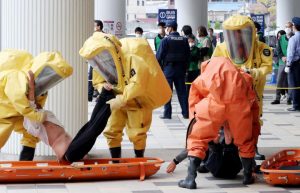Preparations for Hiroshima Summit 2023, Part 2: Impact on lives of local people
Nov. 20, 2022
Citizens worried about high level of security
With cooperation essential, city government focused on raising awareness
by Michiko Tanaka and Mitsuhiro Hamamura, Staff Writers
On November 17, 2022, the shopping mall in Fuchu-cho felt tense as the Hiroshima Prefectural Police and Fire Department conducted drills for how to respond to potential terrorist attacks amid visiting customers. Under the scenario of a simulated attack in which a poisonous substance had been used, shopping-mall employees joined the drills and practiced procedures for rescuing injured people and handling potential toxins. One goal of the prefectural police for holding the drills was to raise the public’s awareness about the risk of terrorism as part of preparations for the summit meeting of the G7 (the Group of Seven industrialized nations), which will take place in Hiroshima in May 2023.
Toshihiro Hirahara, assistant chief of the prefectural police summit-security division, newly established in July, showed enthusiasm for the training. “We plan on continuing to hold the drills into the future.” Only some of their efforts are visible to the public, however. The police department has already undergone training for protection of the summit participants and public security. They also have conducted surveys of areas surrounding summit-related facilities, including the hotels at which leaders are likely to stay.
Both summit venues and downtown areas will be on high alert
The prefectural police are now under enormous pressure. In previous summits held overseas, terrorist attacks and confrontation with demonstrators have resulted in casualties. Unlike the recent summit venues located far from highly populated areas, the upcoming summit in Hiroshima will be held in Hiroshima, with its population of 1.2 million people. That makes it necessary to guard not only the areas surrounding the summit venues but also the city’s downtown. In July 2022, an incident in the streets of Nara City in Nara Prefecture saw the assassination by gunfire of former Japan Prime Minister Shinzo Abe.
Prefectural police management staff signaled their tension regarding the summit. “Ensuring security for the summit is a matter of national pride. Failure is not an option,” said one representative. Japan’s National Police Agency is planning to gather its human resources from across Japan in Hiroshima Prefecture in several stages. The level of security for the Hiroshima event could exceed that in place for the 2016 Ise-Shima Summit, held in Mie Prefecture, for which 23,000 police officers were assembled.
With six months remaining before the start of the Hiroshima Summit, possible impacts on people’s everyday lives due to the heightened security have gradually come to the fore. The prefectural police department has apparently made a string of requests to local resident associations and private companies in the prefecture asking them to provide facilities as standby bases for related operations and other purposes. In several such cases, the police are hoping to start using such facilities in the middle of March 2023.
Chance to take pride in Hiroshima
Motoujina-machi, in Hiroshima’s Minami Ward, will be the area most affected by the summit if the local Grand Prince Hotel Hiroshima is ultimately selected as the summit’s main venue. The small ‘island,’ surrounded by sea on three sides, is home to 740 households and around 1,500 residents. The hotel was previously used as the event venue for the Foreign Ministers’ Meeting held prior to the 2016 Ise-Shima Summit. At that time, ID cards and vehicle passes were distributed to local residents, and starting several days before the meeting, the documents were checked by police whenever people left from or came back to the area. Ships were asked to refrain from navigating the sea area near the island.
Residents of the area anticipate more severe restrictions than the last time and worries are mounting. “When will the restrictions be applied?” queried one resident. “I was told street trees would be cut down if they interfere with security,” said another. Someone also mentioned their concerns about whether “Ambulances might be delayed.” At the time of the Ise-Shima Summit, police staff began to check passersby in Shima City, the location of the main Kashikojima Island venue, starting two months ahead of the gathering. For one week around the summit period, the train line bound for Kashikojima stopped running two stops before the site, with local children having to go to schools in shuttle buses arranged by Japan’s Ministry of Foreign Affairs.
Takaoki Kado, chair of the Motoujina-machi residents association, still has a positive take on the summit. “It’s a meeting to decide the future direction of the world. It’ll be an opportunity for residents to reconsider the attractive qualities of this community and take pride in the area.” On November 6, he called on residents to help clean the island, resulting in more than 100 residents participating in the work. “We were able to pick up bulk trash. I hope our effort can help with security and create a welcoming atmosphere.”
Cancellation or postponement of major events and traffic controls on a large scale are expected during the summit. The prefectural police department will promote awareness about the summit together with the Citizens Council for the Hiroshima Summit, a group consisting of representatives of local governments and private businesses, after restriction details are determined, based on its stance that understanding and cooperation from the people in Hiroshima Prefecture are essential.
(Originally published on November 20, 2022)








